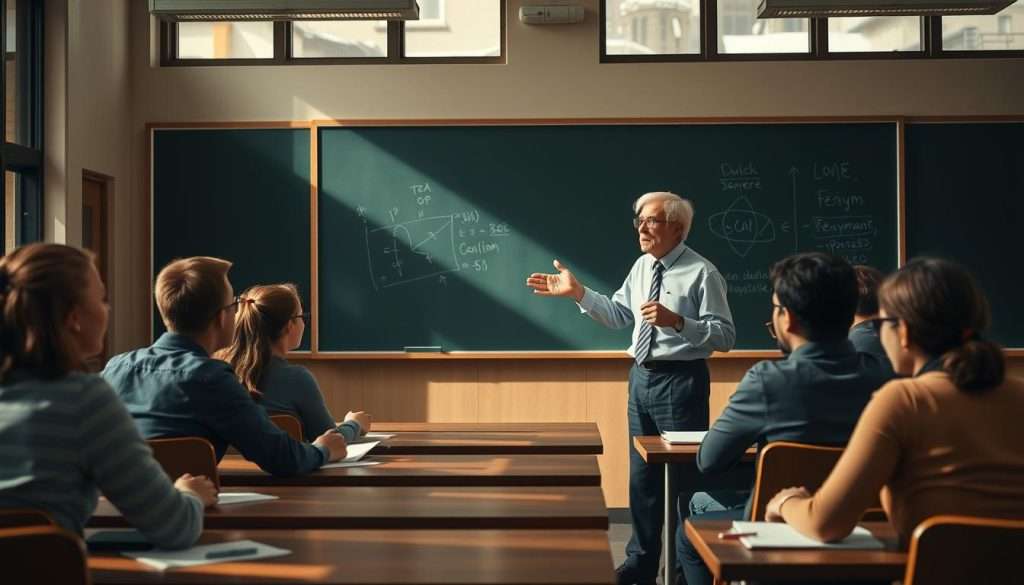Ever wondered how some people learn so fast? They soak up knowledge like a sponge. You can learn like them too!
Everyone learns differently, but the secret to fast learning is using the right methods. Techniques like the Feynman Technique and active recall can boost your learning. These methods help you get and keep information better, making learning fun.
Learning well is not just about knowing stuff. It’s about using what you learn. With the right strategies, you can reach your learning goals quicker and better.
Key Takeaways
- Good learning methods can make you learn faster.
- The Feynman Technique is great for grasping tough ideas.
- Active recall strengthens your learning and keeps it in mind.
- Learning efficiently means using what you learn, not just storing it.
- Choosing the right strategies helps you meet your learning goals sooner.
The Science Behind Effective Learning
Learning effectively is like soaking up information like a sponge. To do this, we must know how our brains handle new info.
How Your Brain Processes New Information
When we get new data, our brains start a complex journey. First, our senses filter it. Then, what’s important gets processed further.
The Neuroscience of Memory Formation
Creating memories is key to learning. It turns info into something we can recall later.
Short-term vs. Long-term Memory Pathways
Info first lands in our short-term memory. It’s either kept and moved to long-term memory or forgotten. Knowing this can help us improve memory skills.
The Role of Neural Connections in Learning
Neural connections, or synapses, are crucial for learning. As we learn, new paths are made, and old ones get stronger.
| Learning Process | Description | Impact on Learning |
|---|---|---|
| Information Filtering | Sensory input is filtered for relevance | Determines what information is processed further |
| Short-term Memory | Temporary holding area for new information | Information is either rehearsed or discarded |
| Neural Connection Formation | New pathways are created, and existing ones are strengthened | Enhances learning and memory retention |
By grasping these steps, we can use cognitive learning techniques and information retention strategies to boost our learning.
Understanding Your Personal Learning Style
We all learn in our own way. Knowing your learning style can really help you learn better. By figuring out how you best take in information, you can make your studying more effective.
Visual, Auditory, Reading/Writing, and Kinesthetic Learners
There are four main learning styles: visual, auditory, reading/writing, and kinesthetic. Visual learners do well with pictures and charts. Auditory learners get information from sounds. Reading/writing learners like text, and kinesthetic learners learn by doing.
How to Identify Your Dominant Learning Style
To find out your learning style, think about how you’ve learned in the past. Do you remember things better when you see them or when you hear them? Do you like doing things yourself or reading about them?
Adapting Techniques to Your Learning Preferences
Once you know your learning style, you can change how you study. For example, if you’re a visual learner, use mind maps and diagrams. If you’re an auditory learner, try listening to podcasts or recording yourself talking about what you’ve learned.
Customizing Study Methods for Maximum Retention
Changing your study methods can really help you remember things better. Here’s a simple table to help you get started:
| Learning Style | Study Techniques |
|---|---|
| Visual | Mind maps, diagrams, infographics |
| Auditory | Podcasts, audio recordings, discussions |
| Reading/Writing | Note-taking, summarizing, reading |
| Kinesthetic | Hands-on activities, experiments, role-playing |
By understanding and adapting to your personal learning style, you can enhance your learning capacity and improve memory retention. Try out different techniques to see what works best for you!
The Power of Active Recall
To really learn new things, you must actively engage with them. Active recall is a key method that boosts your memory by making you recall information from memory. This is better than just reading it over again.
Why Passive Reading Isn’t Enough
Passive reading can make you think you know something when you don’t. Studies prove that active recall is a top way to keep information in your mind. It makes your brain work harder and more deeply.
Implementing Active Recall in Your Studies
So, how do you start using active recall? Start by testing yourself on what you’ve read. Try to remember important points without looking at your notes or the text. It might be tough at first, but it’s a smart way to boost your memory skills.
Tools and Methods for Effective Recall Practice
There are many tools and methods for active recall practice. Here are a few:
| Tool/Method | Description | Benefits |
|---|---|---|
| Flashcards | Physical or digital cards with a question on one side and the answer on the other. | Portable, easy to use, and great for self-testing. |
| Quizzes | Timed or untimed tests on the material you’re studying. | Helps identify knowledge gaps and builds confidence. |
| Self-Testing | Actively recalling information without looking at your notes or resources. | Strengthens memory and improves understanding. |
Flashcards, Quizzes, and Self-Testing Techniques
Flashcards, quizzes, and self-testing can make learning better. For instance, you can make digital flashcards with apps like Anki or Quizlet. These tools help you organize your study materials and make recall practice a regular part of your study routine.
By adding active recall to your study habits, you’ll not only get better at remembering things. You’ll also learn in a more fun and effective way. Try these rapid learning methods today and see how they change your learning!
Spaced Repetition: The Key to Long-Term Retention
Unlock the secret to remembering everything you learn with spaced repetition. This technique fights the forgetting curve. We’ve all been there – cramming for an exam, only to forget most of the material soon after. But what if you could retain information over the long term, making your study sessions more efficient and effective?
The Forgetting Curve and How to Beat It
The forgetting curve is a psychological concept that describes how our brains naturally forget information over time. You can combat this by using spaced repetition. Review material at increasingly longer intervals to help solidify it in your long-term memory. This technique has been shown to improve retention rates significantly.
Creating an Optimal Spaced Repetition Schedule
To get the most out of spaced repetition, you need to create a schedule that works for you. Start by identifying the material you want to retain, then decide on the initial review intervals. Gradually increase these intervals as you become more familiar with the information. You can use a simple table to plan out your review sessions:
| Review Session | Interval | Material Covered |
|---|---|---|
| 1 | 1 day | Introduction to Spaced Repetition |
| 2 | 3 days | Understanding the Forgetting Curve |
| 3 | 1 week | Implementing Spaced Repetition |
Digital Tools for Automated Spaced Repetition
There are several digital tools available that can help automate the spaced repetition process. This makes it easier to stick to your schedule. Some popular options include:
Anki, Quizlet, and Other Spaced Repetition Software
Anki and Quizlet are two of the most well-known spaced repetition software (SRS) tools. They allow you to create digital flashcards and implement spaced repetition algorithms to optimize your learning. You can also explore other SRS tools to find the one that best fits your needs.
Benefits of Using Digital Tools: They save time, reduce the effort needed to manually schedule reviews, and provide analytics to track your progress. By leveraging these tools, you can focus more on learning and less on managing your study schedule.
By incorporating spaced repetition into your study routine, you’ll be able to retain more information over the long term. This makes your learning process more efficient and effective. Give it a try and see the difference for yourself!
How to Absorb Information Like a Sponge Through Visualization
Visualization can change how you learn. It makes hard information easier to remember. Techniques like making mental pictures, mind maps, and visual tricks can boost your learning and memory.
Creating Mental Images for Abstract Concepts
Creating vivid mental pictures is key to learning hard ideas. For example, linking complex science theories to clear images helps you remember better. This way, you make learning more fun and easy to recall.
Let’s say you’re learning about black holes. Imagine a cosmic vacuum cleaner pulling in stars and planets. This makes a hard idea simple and memorable.
Mind Mapping for Visual Organization
Mind mapping is great for organizing info. It’s a diagram that links ideas, starting from a main idea. This helps you see how different info is connected.
Step-by-Step Mind Mapping Process
- Start with a central idea or concept.
- Branches out to related subtopics or ideas.
- Use keywords, colors, and images to make the map more engaging.
- Connect related ideas across different branches.
Visual Mnemonics and Memory Palaces
Visual mnemonics link new info to memorable images. A cool trick is making a “memory palace.” You imagine a place and link info to spots in it.
Building Your First Memory Palace
- Choose a familiar location, like your home or school.
- Visualize walking through this location, noting distinct features.
- Associate the information you want to remember with these features.
- Practice navigating through your memory palace to recall the information.
Using mind maps and memory palaces boosts your memory and learning. They make learning more fun and effective.
| Technique | Description | Benefit |
|---|---|---|
| Mind Mapping | Visual organization of information | Enhances understanding and recall |
| Memory Palaces | Associating information with spatial locations | Improves memory retention |
| Mental Imagery | Creating vivid images for abstract concepts | Makes complex information more memorable |
As Joshua Foer said in “Moonwalking with Einstein,” “The art of memory is about creating a world in your mind where you can revisit the information you’ve stored.” Using these techniques can make you a better learner.
The Feynman Technique: Learn by Teaching
The Feynman Technique is a simple yet effective way to learn complex topics. It breaks them down into simple explanations. This cognitive learning technique involves teaching others what you’ve learned. This way, it reinforces your own understanding.
Breaking Down Complex Topics into Simple Explanations
To apply the Feynman Technique, start by selecting a topic you want to learn. Then, explain it in simple terms as if teaching it to a child. This process helps identify areas where your understanding is weak.
Identifying Knowledge Gaps Through Teaching
As you teach, you’ll encounter gaps in your knowledge. This is a crucial step, as it highlights what you need to focus on. By identifying these gaps, you can refine your understanding and fill in the missing pieces.
Practical Applications of the Feynman Method
The Feynman Technique is a versatile rapid learning method that can be applied to various subjects. It’s particularly useful for complex topics that require deep understanding.
The Four-Step Feynman Process in Action
- Choose a concept you want to learn.
- Explain it in simple terms.
- Identify gaps in your explanation and fill them.
- Review and simplify your explanation.
By following these steps, you’ll not only improve your understanding but also enhance your information retention strategies. The Feynman Technique is a powerful tool for learners. It’s an essential addition to your learning toolkit.

Chunking: Managing Information Overload
When we face a lot of information, our brains can get overwhelmed. But, there’s a simple way to handle this: chunking. It involves breaking down big pieces of information into smaller, easier-to-manage parts. This helps improve how well we learn and remember things.
Breaking Down Large Volumes of Information
The first thing to do in chunking is to find the main points in the information you’re trying to learn. This means dividing big topics into smaller parts and organizing them in a way that makes sense. For example, when studying for a history exam, you might group your study material by era or by important events.
Creating Meaningful Connections Between Chunks
After you have your chunks, the next step is to link them together. You can do this by finding common themes, making mental maps, or using visual tools like diagrams or flowcharts. By connecting new information to something you already know, it becomes easier to remember.
Practical Chunking Strategies for Different Subjects
Chunking strategies can vary depending on the subject. For math, you might group problems by type or by the steps to solve them. In language learning, you could organize by grammar rules or vocabulary themes.
| Subject | Chunking Strategy | Example |
|---|---|---|
| History | Chunk by era or significant events | Studying the American Revolution by breaking it down into causes, key battles, and outcomes |
| Mathematics | Chunk by type of problem or solution steps | Grouping algebra problems by the method required to solve them (e.g., quadratic formula, factoring) |
| Language Learning | Chunk by grammar rules or vocabulary themes | Learning vocabulary related to food by categorizing into fruits, vegetables, meats, etc. |
Using these chunking strategies can greatly improve how you absorb and retain information. Whether you’re studying for a test, learning a new skill, or just trying to stay organized, chunking is a useful tool to have.
Optimizing Your Learning Environment
Let’s look at how to make a learning space that boosts your brain power. Your study area is key to better learning and memory. It helps you learn more efficiently.
Physical Space Considerations for Maximum Focus
To enhance your learning capacity, you need a focused study area. It should have good lighting, comfy chairs, and no mess. Use furniture that’s good for your back and keep your study stuff tidy to avoid distractions.
Digital Environment Management
Just like your physical space, your digital area matters a lot. Organize your computer files, use apps to stay productive, and cut down on digital distractions.
Eliminating Digital Distractions
To stay on track, get rid of digital distractions. Turn off your phone’s notifications, use tools like Freedom or Cold Turkey, and make a “no phone zone” during study time.
The Role of Background Noise and Music in Learning
Background sounds and music can affect your learning. Some people focus better with classical music or nature sounds. Try different sounds to see what helps you concentrate the most.
The Impact of Physical Health on Learning Capacity
Looking after your physical health is key to boosting your brainpower and learning skills. When you focus on your well-being, you’re not just feeling better. You’re also improving how well you can learn and remember new things.
Sleep Quality and Memory Consolidation
Sleep plays a big role in memory consolidation. This is when your brain turns short-term memories into long-term ones. During sleep, your brain goes over and strengthens the connections between neurons. This makes it easier to remember things later.
Optimal Sleep Patterns for Learning
Most adults need 7-9 hours of sleep each night for the best brain function. Having a regular sleep schedule and a sleep-friendly environment can greatly improve memory skills.
Nutrition for Optimal Brain Function
Eating a balanced diet full of nutrients is vital for a healthy brain. Foods packed with antioxidants, omega-3 fatty acids, and vitamins help keep your brain sharp. Adding foods like salmon, nuts, and leafy greens to your meals can really help.
Exercise and Its Effect on Cognitive Performance
Regular exercise does more than just keep your heart healthy. It also boosts your brainpower. Exercise helps with executive function, supports brain flexibility, and even helps grow new brain cells. Adding physical activity to your day can help you use cognitive learning techniques more effectively.

Overcoming Learning Plateaus and Obstacles
We’ve all hit a learning wall with no way out. It’s tough, but there are ways to move past it. Learning plateaus are common, and the right strategies can help you get through.
Recognizing and Breaking Through Mental Blocks
Mental blocks can really hold you back. To get past them, find out what’s causing the block. Is it fear, lack of drive, or a tough subject? Once you know, you can make a plan to overcome it.
Breaking down big topics into smaller parts can help. It makes them easier to handle.
Dealing with Information Fatigue
Too much info can make you feel overwhelmed. To fight this, pace yourself and let your brain absorb new stuff. Using spaced repetition can be helpful. It means reviewing material at longer intervals to lock it in your memory.
Strategies for Maintaining Motivation
Keeping motivated is key. One good way is setting up reward systems. Aim for small goals and treat yourself when you hit them. It could be as easy as taking a break to do something fun.
Creating Reward Systems and Accountability
Having someone to check in with can also keep you going. Find a study partner or mentor for support and encouragement. It can really help your learning journey.
Technology-Enhanced Learning Methods
In today’s digital world, technology has changed how we learn. It offers many tools to boost our brain power. We’ll look at how different technologies can help us enhance learning capacity and memory retention.
Apps and Tools for Accelerated Learning
Many apps help speed up learning. For example, Anki uses flashcards, and Coursera offers interactive courses. These tools use cognitive learning techniques like spaced repetition and gamification to make learning fun and effective.
Leveraging AI for Personalized Learning
Artificial Intelligence (AI) is key in personalized learning. AI tools study how each person learns and adjust content to fit their needs. This creates a learning experience that’s just right for you.
Digital Note-Taking Systems That Enhance Retention
Digital note-taking has changed how we keep and review information. Apps like Notion, Evernote, and Obsidian help us organize and understand better. They make learning stick.
Comparison of Notion, Evernote, and Obsidian
- Notion: Offers a flexible, all-in-one workspace that integrates notes, tasks, and databases.
- Evernote: Known for its robust note-taking features and cross-platform synchronization.
- Obsidian: Provides a highly customizable, markdown-based note-taking system with a focus on local storage.
Using these tech-enhanced learning methods can greatly improve your learning. Whether you’re in school or always learning, the right digital tools can really help your educational journey.
Conclusion: Building Your Personalized Learning System
Learning is a personal and changing process. By knowing your learning style and using methods like active recall and spaced repetition, you can improve a lot. Visualization also helps a lot.
To make your own learning system, try out different ways to learn and remember. Find what works for you and don’t get discouraged if it takes time. The most important thing is to keep trying and think about how you’re doing.
By making learning fit your needs, you can make your study time more effective. This is true for students and anyone who wants to learn more. So, start now and create a learning system that suits you!

